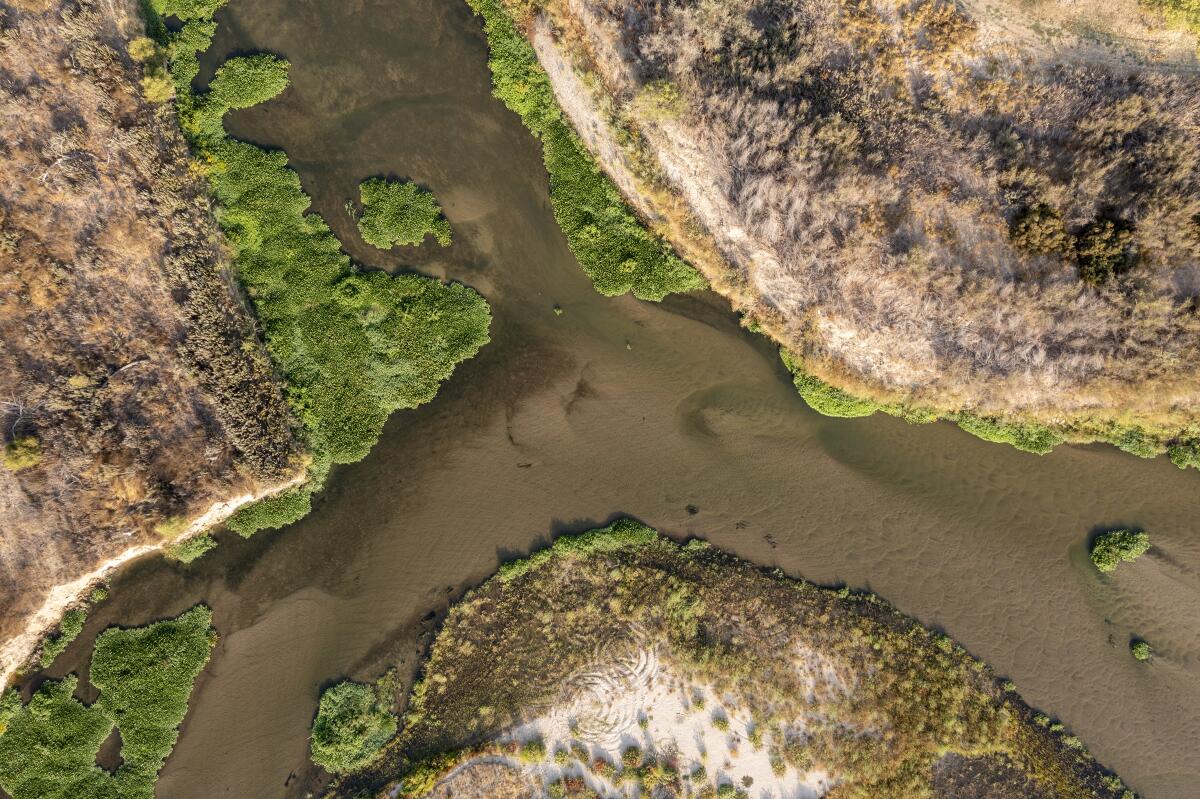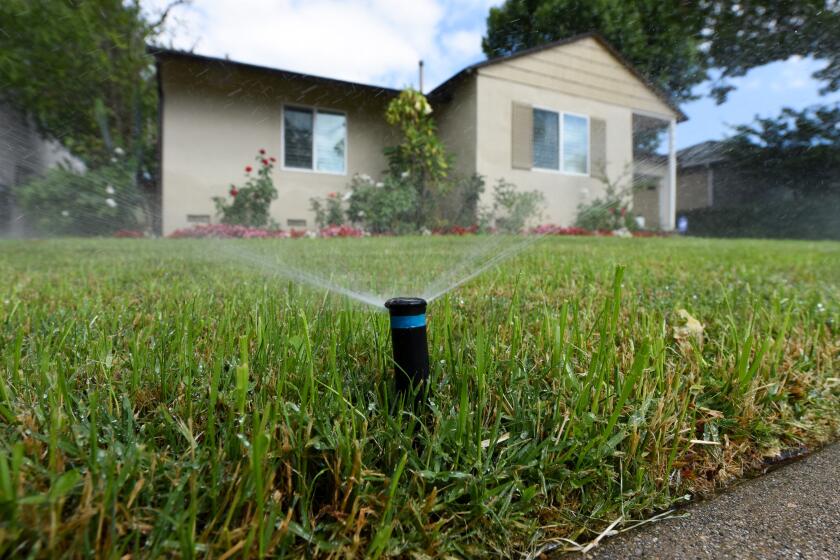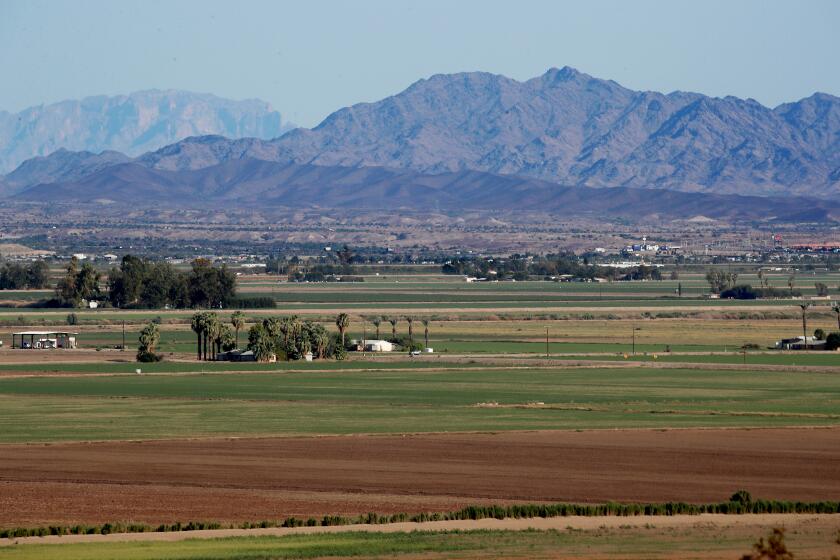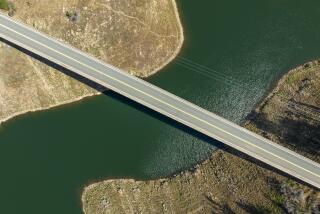Column: California state government is admirably trying to address drought. Itâs a tough nut to crack

SACRAMENTO â We just finished the second-driest water season on record in California. Worse, it was the driest two-year period.
Only 1924 was drier, according to the state Department of Water Resources. And back then, California had a population of just 4.5 million. Now we have 39.5 million people gulping water â plus a lot of overplanted thirsty nut orchards in the arid San Joaquin Valley.
The two dry years âsurpass âthe great droughtâ of â76-â77,â says DWR Director Karla Nemeth. And the most recent drought years in the middle of the last decade âare way back in the rearview mirror now.â
Weâll really be up a dry creek if this winter produces less-than-normal precipitation â whatever normal has become as the planet warms.
So, whatâs being done by the state government about this record drought?
Itâs thrashing around admirably, trying to ease the pain and prepare for a drier future. But, in truth, thereâs not a lot that can be done beyond people using less water, government recycling what they do use, farmers fallowing land and Californians finally dipping earnestly into the worldâs greatest body of water right off our shore.
Desalination is the future, although there are environmental risks, and people living along some beaches may not like it.
Praying for rain and snow doesnât hurt. And those prayers are currently being answered in the Sierra with significant precipitation, including snow in the high country. But no one knows whether thatâs an aberration or the harbinger of a wet winter.
Regardless, Californians â mainly Central Valley farmers â have rights to five times more water than is available even in normal years. But good luck trying to do much about that.
Gov. Newsom declared a statewide drought emergency Tuesday, as officials announced that Californians reduced water use an average of 5% in August.
The fact that weâre the most populous state in the nation is a very mixed blessing and certainly a burden in our efforts to ensure reliable water supply.
When voters approved Gov. Pat Brownâs controversial â and long since heralded â State Water Project in 1960, Californiaâs population was less than 16 million. That project has never really been updated to meet population growth.
Meanwhile, weâve got a different mountain landscape than existed in 1960, let alone 1924.
The stateâs principal watershed, the Sierra, has changed substantially. The ground and atmosphere have become warmer and drier. So, snow and rain soak into the soil or evaporate into the air before the water can become runoff that fills foothill reservoirs.
Thatâs what happened last winter and spring. The Sierra âwas basically a dry sponge,â says Jeffrey Mount, a water scientist at the Public Policy Institute of California.
Sierra runoff that hydrologists expected to replenish reservoirs simply vanished.
Consequently, some of Northern Californiaâs biggest reservoirs are stashing far-below-average amounts of water for this time of year â Shasta 36%, Oroville 37%, Folsom 42% and New Melones 62%.
âThis year caught us by surprise. We have to be honest about that,â Mount says. âIt revealed the weaknesses in our thinking â in our gold rush, year-to-year mentality. The strategy has been that itâs going to rain and snow and become runoff.
âThis is what droughts of the future are going to look like. Itâs going to be tough sledding, to mix metaphors.â
The common public cry is that California needs more big dams and that the state has been derelict in not building them. Well, weâre about done with dams, frankly.
Weâve got a boatload of reservoirs â nearly 1,500. Virtually every California river worth damming already has been. Weâve about run out of feasible locations. The state is riddled with earthquake faults. Thatâs one practical problem.
As Colorado River levels continue to drop, water agencies are working with local growers to leave some fields fallow in exchange for cash payments.
Thereâs a sensible large project being planned in Colusa County, an off-stream reservoir named Sites that would hold 1.5 million acre-feet of water siphoned off the nearby Sacramento River.
Its projected cost: $3.9 billion. The state has tentatively pledged $836 million and the federal government has appropriated $80 million. The remaining money would come from water users. But right now, local sponsors are still enmeshed in environmental reviews. Then the project must acquire permits.
âIf weâd had Sites in place this year, there would have been 1 million acre-feet of water for farms and cities,â says Sites Executive Director Jerry Brown â no relation to the former governor, who lives on his ranch nearby.
âWe need to rethink [water] storage, and I donât mean building a lot of new dams,â Mount says. âWe have an empty reservoir under the Central Valley with a capacity of 100 million acre-feet â empty space thatâs high and dry.â
Heâs referring to aquifers that have been overpumped by agriculture interests to the point where land has sunk significantly in many places, badly damaging irrigation canals.
California was the last Western state in 2014 to regulate groundwater, requiring a balance between pumping and replenishing. But the law wonât be fully implemented for 20 more years.
Gov. Gavin Newsom and the Legislature set aside $100 million this year for canal repairs. They also designated $300 million for groundwater replenishment.
In all, the governor and lawmakers appropriated $5.2 billion over three years for drought relief and longer-range projects, such as grants to help small communities haul in water and to cleanse drinking water.
Newsom declared a statewide drought emergency on Tuesday. That will enable the state to cut corners on red tape to expedite drought relief projects and ban wasting water on such things as driveway cleaning.
âThereâll be more to come â certainly if next year is dry,â Nemeth says.
This is California and the climate is changing. That means if thereâs drought today, flooding canât be far behind.
More to Read
Sign up for Essential California
The most important California stories and recommendations in your inbox every morning.
You may occasionally receive promotional content from the Los Angeles Times.









![[20060326 (LA/A20) -- STATING THE CASE: Marchers organized by unions, religious organizations and immigrants rights groups carry signs and chant in downtown L.A. "People are really upset that all the work they do, everything that they give to this nation, is ignored," said Angelica Salas of the Coalition of Humane Immigrant Rights. -- PHOTOGRAPHER: Photographs by Gina Ferazzi The Los Angeles Times] *** [Ferazzi, Gina -- - 109170.ME.0325.rights.12.GMF- Gina Ferazzi/Los Angeles Times - Thousands of protesters march to city hall in downtown Los Angeles Saturday, March 25, 2006. They are protesting against House-passed HR 4437, an anti-immigration bill that opponents say will criminalize millions of immigrant families and anyone who comes into contact with them.]](https://ca-times.brightspotcdn.com/dims4/default/34f403d/2147483647/strip/true/crop/1983x1322+109+0/resize/840x560!/quality/75/?url=https%3A%2F%2Fcalifornia-times-brightspot.s3.amazonaws.com%2Fzbk%2Fdamlat_images%2FLA%2FLA_PHOTO_ARCHIVE%2FSDOCS%2854%29%2Fkx3lslnc.JPG)



